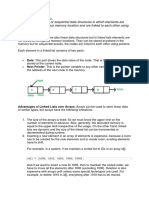0% found this document useful (0 votes)
27 views29 pagesModule 9 - Linked List
A linked list is a linear data structure consisting of nodes that store data and addresses to the next node, with the first node referred to as HEAD and the last pointing to NULL. Operations on linked lists include insertion, deletion, searching, and sorting, which can be performed at various positions within the list. Linked lists are widely used in programming for dynamic memory allocation, implementing stacks and queues, and learning about pointers.
Uploaded by
egujosh321Copyright
© © All Rights Reserved
We take content rights seriously. If you suspect this is your content, claim it here.
Available Formats
Download as PPTX, PDF, TXT or read online on Scribd
0% found this document useful (0 votes)
27 views29 pagesModule 9 - Linked List
A linked list is a linear data structure consisting of nodes that store data and addresses to the next node, with the first node referred to as HEAD and the last pointing to NULL. Operations on linked lists include insertion, deletion, searching, and sorting, which can be performed at various positions within the list. Linked lists are widely used in programming for dynamic memory allocation, implementing stacks and queues, and learning about pointers.
Uploaded by
egujosh321Copyright
© © All Rights Reserved
We take content rights seriously. If you suspect this is your content, claim it here.
Available Formats
Download as PPTX, PDF, TXT or read online on Scribd
/ 29






















































































